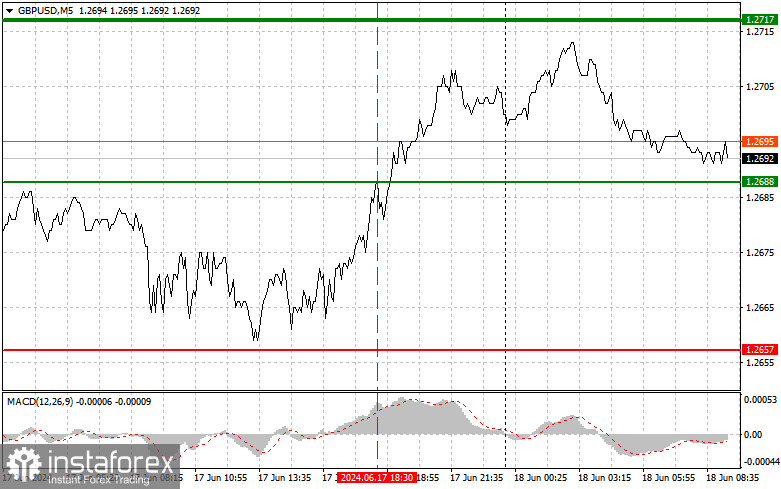Overview of trading and tips on GBP/USD
The price test of 1.2688 occurred at a time when the MACD indicator had moved significantly above the zero mark. Considering that this happened at the end of the day, I did not look for new entry points into the market, as it was clear that there would be no further movement. The absence of UK data, which is the same case today, positively affected the demand for buying the pound, but I don't expect the pair to correct much higher. I do not anticipate a strong rise, as the Bank of England's dovish stance, which will be announced this Thursday, will likely lead to a new GBP/USD sell-off. Thus, the higher the pound goes, the greater the chances of big players returning to the market, expecting the downward trend to continue. As for the intraday strategy, I will rely more on the implementation of scenarios No. 1 and 2.

Buy signals
Scenario No. 1. I plan to buy the pound today when GBP/USD reaches the entry point at 1.2706 plotted by the green line on the chart, aiming for growth to 1.2739 plotted by the thicker green line on the chart. In the area of 1.2739, I'm going to close long positions and open short ones in the opposite direction (expecting a movement of 30-35 pips in the opposite direction from the level). You can count on the pound's growth today after breaching the intraday high, but be careful with long positions. In case the bulls are not active and the pair actively moves up, it is better to leave the market. Before buying, make sure that the MACD indicator is above the zero mark and is just starting to rise from it.
Scenario No. 2. I also plan to buy the pound today in case of two consecutive tests of the price of 1.2682 at the time when the MACD indicator is in the oversold area. This will limit the downward potential of the instrument and lead to an upward reversal of the market. We can expect growth to the opposite levels of 1.2706 and 1.2739.
Sell signals
Scenario No. 1. I plan to sell the pound today after testing the level of 1.2682 (the red line on the chart), which will lead to a rapid decline in GBP/USD. The key target for sellers will be 1.2660, where I am going to close short positions and also open long positions in the opposite direction (expecting a movement of 20-25 pips in the upward direction from that level). You can sell the pound after the pair fails to consolidate near the intraday high. Before selling, make sure that the MACD indicator is below the zero mark and is just starting to decline from it.
Scenario No. 2: I also plan to sell the pound today in case of two consecutive tests of 1.2706 at the time when the MACD indicator is in the overbought area. This will limit the pair's upward potential and lead to a downward reversal of the market. We can expect a decline to the opposite level of 1.2682 and 1.2660.

What's on the chart:
The thin green line is the entry price at which you can buy the trading instrument.
The thick green line is the price where you can set Take-Profit (TP) or manually fix profits, as further growth above this level is unlikely.
The thin red line is the entry price at which you can sell the trading instrument.
The thick red line is the price where you can set Take-Profit (TP) or manually fix profits, as further decline below this level is unlikely.
MACD line: it is important to be guided by overbought and oversold areas when entering the market
Important: Novice traders in the cryptocurrency market need to be very cautious when making decisions to enter the market. It is best to stay out of the market before important fundamental reports are released to avoid getting caught in sharp price fluctuations. If you decide to trade during news releases, always place stop orders to minimize losses. Without setting stop orders, you can quickly lose your entire deposit, especially if you don't use money management and trade with large volumes.
Remember, for successful trading, it is necessary to have a clear trading plan, similar to the one I presented above. Spontaneously making trading decisions based on the current market situation is inherently a losing strategy for an intraday trader.
 English
English 
 Русский
Русский Bahasa Indonesia
Bahasa Indonesia Bahasa Malay
Bahasa Malay ไทย
ไทย Español
Español Deutsch
Deutsch Български
Български Français
Français Tiếng Việt
Tiếng Việt 中文
中文 বাংলা
বাংলা हिन्दी
हिन्दी Čeština
Čeština Українська
Українська Română
Română

